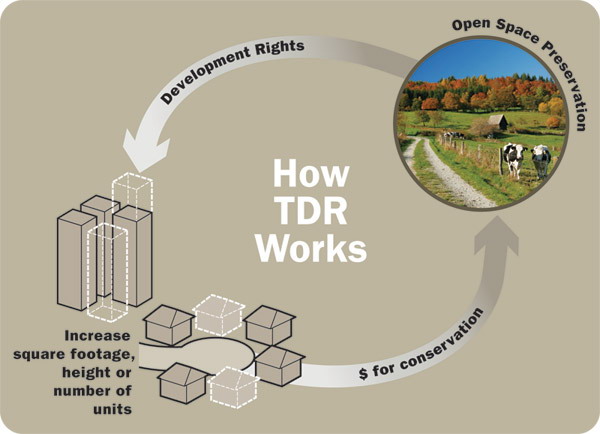TRANSFER OF DEVELOPMENT RIGHTS (TDR) AVAILABLE FLORIDA
Transfer of Development Rights (TDR) Available in Florida
TDR Regulations
TDR regulations were adopted to implement Florida’s Comprehensive plan to preserve wetlands and other environmentally-sensitive areas. As a result of plan review in 1990, the TDR program was expanded to provide density bonus provisions designed to encourage the development in Florida.
Bay Harbor Island – FL – TDR Program
Clearwater – FL – TDR Program
Coral Gables – FL – TDR Program
Crystal River – FL – TDR Program
Delray Beach – FL – TDR Program
Fort Lauderdale – FL – TDR Program
Lee County – FL – TDR Program
Hollywood – FL – TDR Program
Islamorada – FL – TDR Program
Largo – FL – TDR Program
Marathon – FL – TDR Program
Miami – FL – TDR Program
Port Richey – FL – TDR Program
St. Petersburg – FL – TDR Program
Sunny Isles Beach – FL – TDR Program
Tarpon Springs – FL – TDR Program
West Palm Beach – FL – TDR Program
Alachua – FL – TDR Program
Bay – FL – TDR Program
DNC – Charlotte – FL – TDR Program
Collier – FL – TDR Program
Highlands – FL – TDR Program
Hillsborough – FL – TDR Program
Indian River – FL – TDR Program
Lake – FL – TDR Program
Marion – FL – TDR Program
Monroe – FL – TDR Program
Okeechobee – FL – TDR Program
Orange – FL – TDR Program
Osceola – FL – TDR Program
Palm Beach – FL – TDR Program
Polk – FL – TDR Program
Sarasota – FL – TDR Program
St. Lucie – FL – TDR Program
City of Fort Myers
Cape Coral – FL – TDR Program

Process
Sending and receiving sites are proposed as part of applications for Planned Developments. The County Zoning Code prohibits any residential project from exceeding the maximum density limits unless a density bonus is granted through the Planned Development process. Density bonuses are only allowed for the transfer of density from environmentally-sensitive lands.
To transfer density away from environmentally-sensitive areas, a developer proposes a Planned Development which includes both the sending site and an upland receiving site which is not environmentally-sensitive or zoned for agriculture. The density on the upland receiving site cannot be adjusted more than 20 percent of the maximum density allowed by the receiving site’s underlying comprehensive plan land use designation where the receiving site is not adjacent to the area from which the density is transferred. If the sending site and receiving sites are adjacent, the maximum density on the receiving site can be adjusted by 50 percent of the maximum density allowed by the underlying comprehensive plan land use designation.
Available Transfer Residential Development Rights To Enhance Investment Value of Properties For Multi-Family & Other Residential Development Projects In Florida
Background Information:
We are pleased to offer Transfer Development Rights (TDRs) which can be transferred to other properties within the county. The County and governmental regulatory agencies desired to designate this property as conservation and to eliminate development threats and preserve the environmental condition of the property. This property was designated as conservation and development rights were forfeited in order to be awarded the TDRs which can be transferred to other properties more suitable for community development, residential, multi-family, and other projects.
Questions & Answers
1. What can the Transfer Development Rights (TDR’s) be used for?
The TDR’s can be used for residential projects such as multi-family development and other residential projects subject to approval. The TDR’s can result in a 20% adjustment to development rights for properties. For example, if a property is zoned for 150 residential units, the TDR’s can be used to adjust the residential development on the property for an additional 20% which amounts to another 30 units resulting in a combined adjusted total of 180 units. We will work with buyers to secure the TDR transfer approval in a timely and efficient manner.
2. Who can utilize and benefit from these TDR’s?
The TDR’s can be transferred to other properties for use by landowners, investors, and developers for their residential projects.
3. Developers are concerned about expensive delays and long periods of time to secure approval of TDR’s for their projects. How long will it take to secure approval for use of TDR’s?
The TDR’s have already been awarded and the process for approval to transfer the TDR’s for other properties and projects will
take approximately 3 months. As referenced above, we will help buyers secure these approvals and work through the County approval process.
4. Are TDR’s Transferrable?
Yes, TDR’s are transferrable from persons, investors, LLC’s or other business entities, development projects, and between properties within Florida. For example, if a developer purchases TDR’s, they may use the TDR’s for a given project or other projects that they may have in the future.



